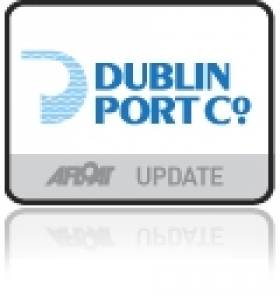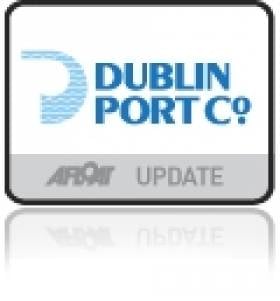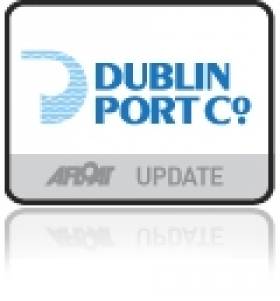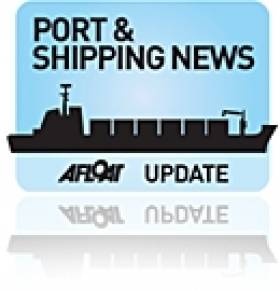Displaying items by tag: Dublin Port
#Aircraft-Carrier- The Royal Navy's HMS Illustrious (RO6) which is the High Readiness Helicopter and Commando Carrier made a rare visit to Dublin Port when the 22,000 tonnes former aircraft-carrier docked at noon today, writes Jehan Ashmore.
The last of the 'Invincible' class of aircraft-carriers commissioned for the Royal Navy is in the capital as part of an international naval flotilla which are arriving at various stages today, having just completed a major multi national warfare exercise off the coast of Scotland.
Captain Martin Connell, Commanding Officer said: "We are really delighted to be visiting Dublin, especially during the period of The Gathering."
To mark her visit to Ireland during the Gathering, HMS Illustrious will be floodlit in green. Captain Connell added "we have been kindly donated some high powered green lighting. We are all looking forward to seeing the end effect."
HMS Illustrious which otherwise is known affectionately by all aboard as 'Lusty' – which used to carry 'Harrier' VSTOL jump-jet aircraft is due to pay off after 32 years sterling service in 2014 to make way for the next-generation aircraft carriers.
As previously reported on Afloat.ie, on the other side of the Irish Sea, she made a call to Liverpool in February on what was likely to be her last call to that city as part of a farewell UK tour of ports.
As regards HMS Illustrious's last call to Dublin Port, this was back in 2005 where she docked along the south quays, whereas on this occasion she is moored in Alexandra Basin, facing opposite the Poolbeg Yacht & Boat Club marina in Ringsend.
She is to remain in the port over the weekend and depart on Monday.
Dublin Port Company to pay €7m Dividend to the State
#DublinPortAGM – At the AGM of the Dublin Port Company today, it was announced that the port will pay a €7m dividend to the State in June 2013 based on its financial results for the year ended 31 December 2012.
The dividend represents a distribution of 30.7% of profit after tax and brings total dividend payments to the State to €53.8m over the last seven years.
While there were headline reductions in Turnover and Profit after tax, the underlying profitability of the business remained strong in 2012 with Operating Profit increasing by 4.6% from €27.8m to €29.1m.
At today's AGM the Annual Report for 2012 was presented to the Company's shareholders in advance of publication later this year after it has been laid before the Houses of the Oireachtas.
Speaking about the financial performance of Dublin Port Company for 2012, Minister for Transport, Tourism and Sport Leo Varadkar said: "I commend Dublin Port Company on its financial performance in 2012 and for once again paying a dividend to taxpayers. Dublin Port is an exemplary company which has consistently paid a dividend to the State at or above the level expected by Government.
The Port plays a crucial role for the economy at local and national level, which was acknowledged in the Government's recently published National Ports Policy."
Addressing Dublin Port Company's AGM, Ms Lucy McCaffrey, the Company's Chairperson said: I was pleased to present the company's annual report for 2012 to our shareholders and to confirm to the representatives of the Minister for Transport, Tourism and Sport and Minister for Public Expenditure and Reform that the company will pay a dividend of €7m to the State in June 2013.
The continued strength of the company's finances will ensure that the company is well positioned to deliver the key infrastructural developments envisaged in the Masterplan 2012-2040 which the company launched last year.
#Cruiseliners -Discovery not only has the distinction of becoming the first cruise caller to Dublin Port in 2013 but also under the brand of Cruise & Maritime Voyages, writes Jehan Ashmore.
The 700 passenger capacity vessel docked today at Ocean Pier having departed her homeport of Avonmouth yesterday for the start of this year's cruise season.
Discovery of 20,000 tonnes and built in 1972 will be followed by fleetmate Marco Polo with a call on Friday to Dublin Port where the port is to welcome another record-breaking season with around 100 calls, with the Gathering being a major visitor draw.
As previously reported on Afloat.ie the giant 2010 built $547m MSC Magnifica of 95,000 tonnes which has more than 1,500 cabins accommodating a maximum 3,223 passengers, is to make her maiden 'Irish' call in late May.
The 294m 'Musica' class vessel is a larger fleetmate of Mediterranean Shipping Company's MSC Lirica, which last year also made a debut docking to Dublin Port and Cobh.
Other large callers to Dublin Port are Caribbean Princess, Celebrity Infinity and Queen Elizabeth which made her inaugural Irish call in 2011.
In addition The World, which also makes a return to the capital following her first ever call to Galway Harbour with an 'anchorage' call in early July.
Last year approximately 90 individual cruise calls were made to the capital which welcomed 100,000 passengers and brought between them €35-50m to the local economy.
With the increase in calls during 2013, the Dublin Port Company is to address future demand through its Masterplan 2012-2040, with a proposed new dedicated cruise terminal completed by 2015.
The facility would be sited along North Wall Quay Extension close to the East Link Bridge.
Duke Class Frigate to Dock in Dublin Port
#FrigateVisit-The Royal Navy Type 23 Duke Class frigate HMS Richmond (F239) is to make a weekend courtesy call to Dublin Port, with an arrival to the capital this afternoon, writes Jehan Ashmore.
The 4,900 displacement frigate commissioned in 1995 has a top speed 28 knots and a crew complement of 185. She and her 12 sisters are among the most tried and tested in the fleet, having pounded Saddam Husseins defences on the Al Faw peninsula in the opening hours of the Iraq campaign a decade ago in 2003.
HMS Richmond has undergone an upgrade to sensors and weapons systems, where Seawolf Mid-Life Update (SWMLU) are now fitted that will improve the ship's ability to meet the evolving capability of anti-ship missiles. In addition the frigate has 30 mm Automated Small Calibre Gun (ASCG) system making her a formidable and modern weapons platform.
Scientific ‘Explorer’ Makes a Fleeting Call to Dublin Port
#IrishSeaSurvey – The Marine Institute's Galway based RV Celtic Explorer made a brief call yesterday to Dublin Port, while in between carrying out separate scientific surveys, writes Jehan Ashmore.
The 65m vessel, which is not a regular visitor to the port, had berthed at Ocean Pier. According to the Marine Institute's vessel survey schedule, she was conducting a Methane-derived Authigenic Carbonate (MDAC) survey headed by chief scientist Dr. Yvonne Leahy of the institute.
The survey was to complete a drop camera survey of a MDAC site in the Irish Sea, some 25 nautical miles offshore of Dublin Bay.
Celtic Explorer which is 2,425 tonnes and has a total of 35 personnel, and equally the same number of days in endurance range. Accommodation is for 22-30 scientists, 13-15 crew (dependent to operational requirements). Scientific quarters are for 4 single cabins and 9 double en-suite cabins.
Her inshore fleetmate, the 31m RV Celtic Voyager of 340 tonnes has an endurance capability of 14 days. A total of 15 personel made up of 8 scientists and 7 crew are accommodated in 4-berth quarters.
On the Radio: Dublin Port and the Work of the Dockers
#OnTheRadio – A talk about Dublin Port and the life and work of dockers will be broadcast from the decks of the Jeanie Johnston today between 3-5pm on Near 90.3FM
Those involved in the broadcast are from the Dublin Dockworkers Preservation Society. At last year's Tallships Festival, the society held a photographic display depicting port scenes down through the decades.
Lecture: Lighthouse Memories of “Round Ireland Lighthouse Tour”
#LighthouseLecture- An illustrated lecture: 'Round Ireland Lighthouses Tour' by John Donnelly and Brian Maguire will be held next Wednesday (16th Jan.) at Poolbeg Yacht & Boat Club, Ringsend, in the heart of Dublin Port.
Donnelly and Maguire worked as Engineers for the Commissioners of Irish Lights (CIL). Between them they have seventy year's experience covering the period when the lighthouses were manned and their subsequent automation.
Their presentation will feature the history of the various lighthouses along with numerous photographs and personal anecdotal memories.
The lecture starting at 20.00hrs is part of Public Les Glenans Irish Winter Lecture Series and an entry fee of €5 will be in aid of the RNLI.
Tug that Righted “Rambler 100” Barges Ahead
#TOWAGE – The tug Ocean Bank that righted the capsized US entrant Rambler 100 following the Rolex Fastnet Race 2011, arrived in Dublin Bay recently with a barge under tow, writes Jehan Ashmore.
The Rambler 100 had overturned in force-five winds off Fastnet Rock arising from "dramatic and catastrophic" failure of the keel triggered events that ultimately delayed the rescue of the majority of her 21-strong crew, according to the official report by the MCIB into the capsize.
After the rescue of Rambler 100's crew, the yacht remained adrift but eventually was recovered by the Bere Island based tug Ocean Bank to the shelter of Barley Cove, west Cork. From there the 30 tonne bollard pull tractor tug operated by Atlantic Towage & Marine successfully up-righted the yacht.
This week's operation by the Ocean Bank involved towing a completely different type of vessel, the construction barge Skerchi from the south-west coast to a berth alongside Ocean Pier in Dublin Port.
Dutch Shipping Company Seek Professionals and Trainees
#CAREERS AT SEA - The two multi-purpose heavy cargoships that last month discharged windmill components in Dublin Port, are owned by Dutch based Abis Shipping who are currently offering traineeship opportunities, writes Jehan Ashmore.
The pair had met together in the port the same morning, where the newer and larger D-class Abis Dover arrived first followed by the smaller B-class Abis Belfast. As previously reported, they belong to a 14-strong fleet managed in Harlingen, where a local shipyard is to complete newbuild Abis Dublin with a delivery scheduled for this month.
With an expanding fleet of newbuilds, the progressive company which only formed in 2007 is seeking to grow with professionals in training or to those just finished studying. They, regularly have traineeship vacancies run through a nautical support department so to meet demands of charterers. Vacancies currently available are for Captain (D.P.O.), Chief Engineer and Chief Officers (D.P.O.). For further details visit this LINK.
Patrol Ship Purchased, Dublin Dry-Dockings, Belfast Port Masterplan, IMDO Launch Report, Naval and Cruiseship News
#PORTS & SHIPPING REVIEW - Over the last fortnight Jehan Ashmore has reported from the shipping scene where the Royal Navy's fishery patrol vessel HMS Mersey docked in Dublin Port, having been purchased from her shipbuilder-owners as part of a £39m deal.
One of the largest vessels of the Arklow Shipping Ltd fleet, Arklow Manor of 9,682grt/14,008dwt arrived in Dublin Port to enter the dry-dock facility, one of her sisters had also used the dry-dock in Alexandra Basin earlier this year.
P&O Cruises Adonia, became the final cruise caller to Dublin Port this year, having spent a day at sea after departing Cobh Cruise Terminal the previous day. She led the fleet during the 175th anniversary 'Grand Event' which formed one of the lectures during last month's London Ship Show.
A Masterplan setting out the future for the next 20-30 years for Belfast Harbour was launched, those interested in making comments on the plans are asked to respond by 7 December.
The Irish Maritime Development Office (IMDO) released a report of the nine semi-state port's financial statements for the year end 2011. A key finding is that after a combined growth of 3% in turnover in 2010, the ports recorded a fall in turnover of 3% in 2011 with turnover falling to €120m.
Naval Service OPV L.E. Emer (P21) detained an Irish fishing vessel off the south-east coast over alleged breaches of fishing regulations and was escorted to Cork and handed over to the Gardai.
In 2013 Cruise & Maritime Voyages are to charter Discovery (1971/20,216grt) for the UK cruising season. She is scheduled to make her debut 'Irish' port of call to Dublin Port in April, which will also mark the start of the cruise season to the capital.






































































